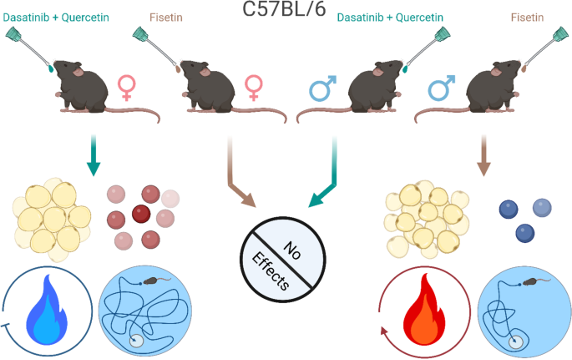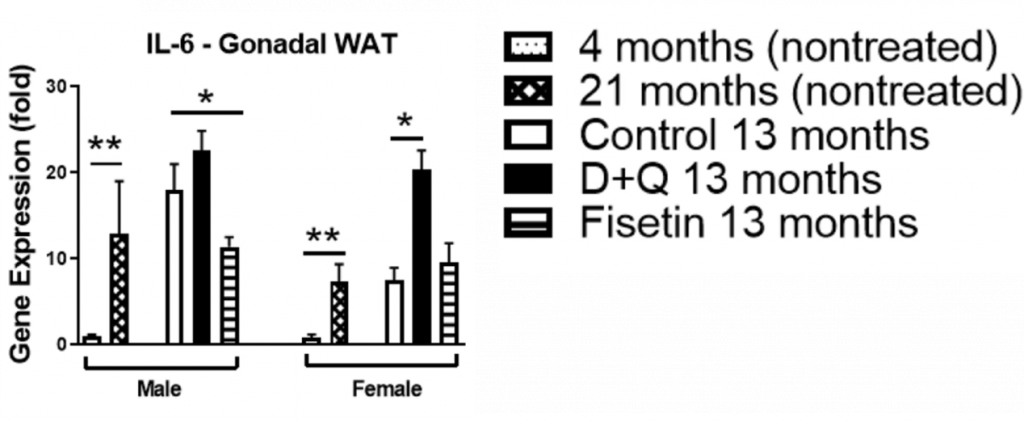Key Points:
- Early D+Q intake increases inflammation in females, while fisetin intake reduces inflammation in males.
- D+Q increases body fat in females, and fisetin lowers blood glucose levels in males.
- Fisetin improves cognition in males, while D+Q impairs cognition in females.
Fisetin and D+Q are known for their anti-aging effects when administered to older rodents. Because of this, and the fact that they are available without a prescription, many individuals have begun supplementing with fisetin or Q — both plant-derived flavonoids. However, studies exploring the effects of these senolytics when administered to younger rodents are lacking. Researchers from the Southern Illinois University School of Medicine say:
“It seems possible that the earlier in life [senolytics] are taken, the better likelihood of delaying age-related decline and disease risk might be expected. Senolytics such as Fisetin and D + Q are known to reduce senescent cell burden, but the optimal age to begin treatment is currently unknown.”
Now, these researchers have discovered that not all senolytics provide anti-aging effects when taken early in life. As reported in GeroScience, Fang and colleagues show that D+Q has detrimental effects on young female mice and no effect on young male mice. Additionally, fisetin has no effect on young female mice and has beneficial effects on young male mice.

Fisetin Benefits Younger Males while D+Q is Detrimental to Younger Females
Senolytics are compounds that selectively eliminate senescent cells. Senescent cells accumulate with age and may drive the aging process. Thus, eliminating accumulated senescent cells may slow aging. Still, it remains unclear whether eliminating senescent cells before they accumulate triggers slowed aging. Therefore, Fang and colleagues treated young (4-month-old) mice with 100 mg/kg of fisetin, or 5 mg/kg of D and 50 mg/kg of Q each month for nine months.
Upon analysis of gene activation, it was found that treating young female mice with D+Q elevates SASP factor genes in fat tissue. SASP factors are secreted by senescent cells and promote inflammation, which is thought to largely contribute to the aging process. In contrast, D+Q had no effect on SASP factors in males. Fisetin, on the other hand, reduced fat tissue SASP factors in male mice and had no effect on SASP factors in female mice. Similar results were observed in the brain and blood tissue.

When looking at body composition, D+Q treatment increased the weight of female mice, which was due to an increase in total body fat. In male mice, D+Q had no effect on weight or body fat. Furthermore, fisetin had no effect on weight or body fat in male or female mice. Since Q has been shown to lower estrogen levels and estrogen promotes fat deposition, the authors speculate that the Q in D+Q lowers estrogen in females, prompting fat accumulation.
Fang and colleagues next found that fisetin treatment reduced blood glucose levels in male mice. In contrast, fisetin had no effect on blood glucose levels in female mice. Moreover, D+Q had no effect on blood glucose in either male or female mice. Further analysis showed that, in male mice, fisetin increased energy metabolism and caused a switch from metabolizing carbohydrates to metabolizing fat, although D+Q decreased energy metabolism in female mice.

To measure learning, Fang and colleagues placed their mice into the Morris water maze (see video to learn more). The Morris water maze involves mice swimming in a pool of water to find a platform to escape from drowning. The mice were trained to find the platform over the course of five days. By the fifth day, the male mice treated with fisetin found the platform more efficiently, suggesting improved learning. This did not occur in male mice treated with D+Q or female mice treated with either fisetin or D+Q.
Another cognitive test called the novel object recognition (see video to learn more) was used to assess memory recall. This test involves mice exploring new objects over familiar objects. Since mice enjoy new objects, exploring new objects instead of old ones is suggestive of them recalling the old object. Female mice treated with D+Q were found to explore new objects for less time than untreated females, interpreted as impaired memory. This did not occur in the female mice treated with fisetin or male mice treated with either senolytic.

Overall, the findings of Fang and colleagues suggest that D+Q has pro-aging effects on younger females, while fisetin has no effect. In contrast, fisetin has anti-aging effects on younger males, while D+Q has no effect. Some of this could be explained by male mice aging faster than females leading to more dramatic shifts in aging impairments. For example, untreated male mice had higher levels of SASP factors like IL-6 compared to untreated female mice. As such, senolytic treatment more significantly reduced IL-6. The authors add:
“Unfortunately, data regarding [sex differences] are only beginning to emerge due in large part from “male centric” sampling in both preclinical and clinical research. Sparse evidence suggests females maintain better cellular health throughout the majority of their life, but become more frail when approaching death compared with males.”
What Age Seems Best for Beginning Senolytic Treatment?
Fang and colleagues began treating mice with senolytics at 4-months-old, equivalent to about 25-years-old in humans. Based on this one animal study, it does not seem beneficial to begin supplementing with either D+Q or fisetin for females at this age. For males, fisetin, but not D+Q may potentially be beneficial at this age. However, it is not recommended to make decisions based on any single study, especially an animal study.
With this in mind, several animal studies suggest that senolytics can be beneficial when taken around middle-age. In Fang and colleagues’ study, IL-6 levels were similar between untreated 13-month-old and 21-month-old mice, equivalent to about 46 years old and 63 years old in humans, respectively. This could mean that beginning D+Q or fisetin supplementation may be beneficial at these ages.
Still, what also needs to be taken into consideration is that emerging research shows that not all individuals age at the same rate at the biological level. Therefore, compared to chronological age, assessing one’s biological age is likely a better indicator of whether senolytics would have any beneficial effects. Other indicators that don’t require costly biological age measurements include having a metabolic disorder like obesity or type 2 diabetes, which seem to accelerate the aging process.